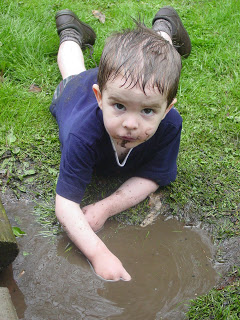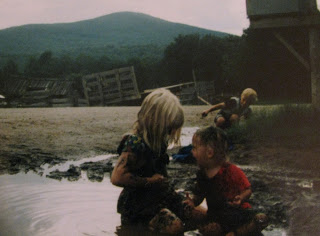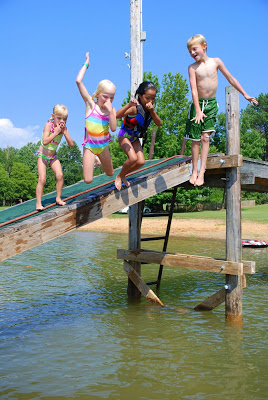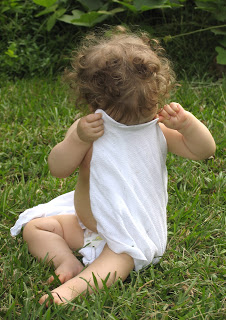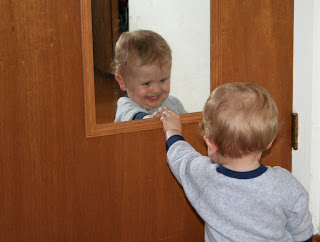“I’ve developed a new philosophy…I only dread one day at a time” ~ Charlie Brown (a.k.a. Charles Schulz, Creator of the world-famous comic strip Peanuts, 1950-2000)
Monthly Archives: May 2011
5-Minute Courage Workout: Talking Dirty
Here’s a list of 5-Minute Courage Workouts by age range to boost confidence in our dirt-deprived and germophobic world.
- Toddler: at this age, your child is likely perfectly comfortable getting down and dirty. At dinner tonight, put away the cutlery and eat with your hands. Enjoy the texture, the colors, the sheer squishy sensation of feeling your food before you eat it. If you didn’t pick the ingredients from a garden, tell a five-minute story about the journey your food has taken to get to your plate. Imagine the worms that fertilized that garden squirming around your food just before the farmer’s hand pulled it out of the ground. Say a blessing for all involved in helping plant, grow, tend, harvest, package, and deliver your daily food.
- Preschooler: get some vegetable or flower or herb seeds, find a spot in the yard or pot you can fill with dirt, and plant the seeds with your child: no gardening gloves allowed! Or find a lonely, long-forgotten houseplant stashed somewhere in your home and offer it a fresh start in a bigger, nutrient-rich, new dirt home (either in your garden or in a larger pot). Notice where your comfort zone ends with getting dirt under your nails or on your clothes. Water the earth until it’s nice and muddy and pat down the surface together with loving care. Talk about how the dirt will give nourishment and protection to the seed while it grows. See dirt as life-giving and positive rather than a menace.
- Early elementary student: it’s probably been a few years now since your child has run barefoot around the yard, on the beach, or on a playground. It’s time to kick off the shoes and find some interesting paths to walk barefoot. Spend five minutes finding as many different surfaces to walk on — some surfaces may even hurt if your tender toes have been cooped up too long. This is where some physical courage might come in handy!
- Upper elementary student or ‘tween: See if you have any long-forgotten clay or a tube of facial mud mask around the house. Plan to spend five minutes with your hands in the clay sculpting some exotic creature, or give each other a five-minute mud mask facial. If you have the opportunity, on the next rainy day find a mud puddle and surprise yourself and your child by sitting in it! Let go of the worry of dry-cleaning costs and what the neighbors may think. Bask in the healing properties of mud; have you ever noticed how contented pigs seem to be? There’s a reason. Let the nutrients in the mud rejuvenate you and your ‘tween.
- High schooler or teen: It’s time for your teen to cook tonight. The meal could be as simple as spaghetti or scrambled eggs, but it’s going to be served with a twist. Tonight, dinner is to be served on the floor! We are not suggesting that you simply sit on the floor to eat off your plates, but that you actually eat off the floor. This could bring up all kinds of inner and outer resistance; notice what you’re feeling and explore with your teen what’s coming up for them. This may provide the perfect opportunity to test what you and your child’s comfort level with getting down and dirty is just before they leave home and eat off someone else’s floor. You could also try just eating on the floor together, as many cultures around this world do everyday. You may need to revisit some of the earlier dirt workouts if your teen seems to have skipped a few stages of getting comfortable with dirt. Improvisational workouts like this provide an opportunity to practice the kind of emotional, social, physical and for cognitive flexibility that today’s world requires.
We’d love to hear about your results with one of these workouts, or share your own!
Let’s Talk Dirty
I am a gardener. I get dirty. I often wear dark nail polish in the summer to hide how unscrubbably grimy my fingernails have become.
 Physical courage allows us to experience the world without layers and layers of protection – it allows us to experience the world directly, with all of our senses. I always assumed kids were supposed to get dirty. I know I got dirty. I ran barefoot and had scabs on my knees and tree sap in my hair. I stubbed my toes a lot, and endured many painful splinter extractions. But I also caught crayfish in streams, and built forts under giant bushes, and ate raspberries right off the prickery canes. I climbed trees and onto the house roof to smush my fingers into soft, warm tar on summer afternoons. I’ve gone camping and eaten food with sand and ashes in it, and wiped my knife “clean” on my dirty jeans. I don’t want dirt to cause my daughter to hesitate as she experiences the world. And so far, judging by the state of her clothes, it doesn’t!
Physical courage allows us to experience the world without layers and layers of protection – it allows us to experience the world directly, with all of our senses. I always assumed kids were supposed to get dirty. I know I got dirty. I ran barefoot and had scabs on my knees and tree sap in my hair. I stubbed my toes a lot, and endured many painful splinter extractions. But I also caught crayfish in streams, and built forts under giant bushes, and ate raspberries right off the prickery canes. I climbed trees and onto the house roof to smush my fingers into soft, warm tar on summer afternoons. I’ve gone camping and eaten food with sand and ashes in it, and wiped my knife “clean” on my dirty jeans. I don’t want dirt to cause my daughter to hesitate as she experiences the world. And so far, judging by the state of her clothes, it doesn’t!Courage Quote of the Day
Another Lion Story (actually two!)

A startling video on YouTube made the rounds a few years back, about a lion named Christian and the two men who had raised him. The background is that in 1969 these men saw a lion cub for sale in London (let’s not even begin to talk about how this could have been legal) and brought it home, raising it in their apartment and exercising it in the neighboring churchyard. Inevitably, this male lion (named Christian) became too big, and the young men did what they must to reintroduce it to the wild in Africa. More than a year later they returned to look for their old friend; the lion came to them and embraced them, rubbing against them like an overgrown kitty, and even introduced them to its wild-born mate. Watching this video (with a power ballad soundtrack!) brings tears and also the question – how could those men be so sure they were safe? What sort of courage is that?
Courage Book Review – Three by Idries Shah

 Another fine example of intellectual courage is Fatima the Spinner and the Tent
Another fine example of intellectual courage is Fatima the Spinner and the Tent Last, we offer The Old Woman and the Eagle
Last, we offer The Old Woman and the EaglePeek-a-Boo!
Little did I know that all the hours of playing Peek-a-Boo with my children actually produced necessary neuronal growth in their brains so they can feel secure in this world! Peek-a-Boo teaches our child that we are a secure object. I thought we were just having fun!? That’s the cool thing about putting psychology research into practice, it can be fun. Research now shows that many time-honored traditions in parenting help create the trust and courage in kids necessary to conquer many of life’s challenges.
Our family game was actually called, “Peek-a-Boo, I Love You.” As soon as I would reappear, I would reassure my child that I really was back with a big smile, open arms, eye-to-eye contact, say “I see you” and, what would eventually become one of their first phrases, “I love you!” I made sure to give the same verbal and non-verbal cues every time I would go away and come back once I started having other caregivers help in caring for my children. Consistency being an important key to unlocking the treasure trove of trust between parents and children!
Schore, A. (2001). Effects of a secure attachment relationship on right brain
Courage Quote of the Day
“Real difficulties can be overcome, it is only the imaginary ones that are unconquerable.” ~ Thomas Vail
5-Minute Courage Workout: Saying “I’m Sorry”
Saying “I’m sorry” takes emotional and moral courage. Learning about the true purpose and importance of making an apology begins and ends with empathy.
Hopefully, by supporting our children to develop emotional intelligence, empathy for others, and a sense of personal responsibility (whilst continuing to develop these skills ourselves) we can all help create more peace in ourselves, our community, and our world.
- Toddler: play I Spy the Feeling! while people-watching on your adventures around town today, or in the books you read together at bedtime, play-act different feelings with a puppet, or sing a five-minute rendition of “If You’re Happy And You Know It” about feelings and act-out the matching body language. The child who can say, “I’m mad!” is less likely to become so frustrated he/she will strike out. If he/she does strike out, let them know “That hurt! If we hurt someone, we say ‘I’m sorry’.” If you do something hurtful accidentally, like stepping on a tiny toe or bumping into each other, look your toddler in the eye and say “I’m sorry I stepped on your toe. Are you okay?” Just like please and thank you, I’m sorry can now begin to be part of your child’s developing vocabulary.
- Preschooler: play the Let’s Take Turns game. Sharing is an important first step in building the kind of empathy and self-control associated with social and moral courage. Use a kitchen timer, if necessary, to help your child and his/her brother, sister, or friend take turns with a toy (you can practice with your child first, too)—don’t start with one of their favorite toys and keep the time limit short (2-5 minutes each to start)! Allow them the opportunity for success. Have them each pick two toys they’d like to practice sharing. At the start of the game, say “We’re going to play a sharing game today so you both get a chance to play with these toys. We are going to use a timer and when your turn is done, you give the toy to Sam and you give your toy to Ella.” At the end of the time, say “It’s time to share your toy. After their turn, you will get another chance to play with it.” Use praise. “I noticed that as soon as the timer rang, you both shared your toys. What caring friends you are to share! Now everyone has a chance to play with the toy today.” If one or the other child grabs the toy before the end of the time, make sure he/she knows to say “I’m sorry I took the toy” and returns it. Start the timer again.
- Early elementary student: your child’s cognitive development has now progressed to the stage he/she is able to empathize. The world of right and wrong is now viewed through black and white lenses. Deepening your child’s understanding that not everyone experiences everything he/she does in the same way will be important now. For example, you may hear your child say “Well, I didn’t mean to break your cup, slam the door, etc. It was an accident!” It will be important to teach your child that even if something is an accident, their behavior has an effect. Letting our child off the hook at this stage (when they have done something wrong), and continuing to let them off the hook as they mature, may be the very reason some adults on Wall Street have yet to take responsibility for their actions and the consequences. Children at this age are now becoming aware that they may have made a mistake or done something hurtful, but being worried about what others think of them may cause them to be shy about saying “I’m sorry” and/or taking responsibility for their action. Start with a 5-minute review of classroom and family rules. Discuss together over dinner tonight these two questions: “Why are rules important?” “Why is saying ‘I’m sorry’ important?”
- Upper elementary student or ‘tween: you may be hearing a lot of “I’m sorry…OKAY?!” at this stage. Many kids are usually more than familiar with the throw-away version of the apology, couched in sarcasm and not an ounce of regret. Here’s where parents can get creative and encourage children to brainstorm ways to “make amends” for their misdeed to get the full-impact of what an apology is really about. One evening this week, consider spending five minutes writing together, on small slips of paper, something you would like to apologize for (be specific) but haven’t had the courage yet to do so. The goal is to get any free-floating guilt on paper, whether or not you follow through immediately with the apology or not. Then, share with one another your misdeed and intended apology. Discuss some of the barriers standing in your way: embarrassment, too much time has passed, fear of being judged/excluded, not really liking the person you hurt, etc. Decide together if the true forgiveness needed is actually self-forgiveness? Or does a phone call need to be made, a note written to the special someone you wish to apologize, or simply a behavior changed?
- High schooler or teen: by the time our kids are teenagers, there are usually plenty of opportunities to apologize to our kids—heck we’re all hormonal by this stage! On your drive to work, walking the dog, or just before bed spend five minutes reflecting on something you may have done that you would like to apologize for. Now apologize. For example, “Kyle, I’m sorry I said how stinky your socks were in front of your friends. I am aware that I thought I was being funny, but noticed you may actually have been embarrassed. I’m sorry for saying something potentially embarrassing about you. I will be more mindful in the future to wait until we are alone together to suggest you use the foot odor spray we bought for your shoes. I hope you can accept my apology.” Then, make sure you follow through with said behavior change so your teen will, too!
Guilt is a powerful psychological mechanism that warns us when something is wrong, amiss, out of balance, or that a mistake’s been made. Guilt’s purpose is to help us correct our course and move forward unburdened. Sometimes saying “I’m sorry” is the first step to unburdening. Oftentimes, however, when we are forced to say “I’m sorry” prematurely or without a complete understanding of what these two short, but powerful, words actually mean, we can transform guilt into shame. Shame has a nasty way of keeping us stuck in the same behaviors that got us into trouble in the first place, and we end up feeling unworthy, suffer from low self-esteem, and can become socially isolated. As a parent, you are a powerful role model for your child to learn loving communication, assertiveness, and how to use his/her voice to express concern, care, and culpability (when necessary).
Working on these skills may call upon different types of courage, depending upon your child’s particular strengths and/or temperament. For example, asking some children to apologize may take emotional courage, for others social courage to do the same task. Review the Six Types of Courage to figure out which types your child needs to complete this workout.
If you’re looking for more workouts, here’s our 5-Minute Courage Workout: A Fate Worse Than Death , 5-Minute Courage Workout: Talking Dirty, 5-Minute Courage Workout: It’s a Dog Eat Dog World, 5-Minute Courage Workout: Home Alone, 5-Minute Courage Workout: A Fate Worse than Death, 5-Minute Courage Workout: Playing with Fire, 5-Minute Courage Workout: Navigating the Neighborhood
Meat of the Tongue
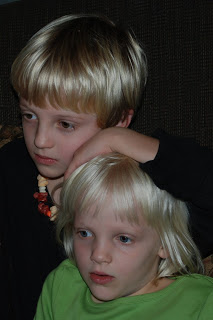 Okay, by now some readers may be ready to give up on me and my fairy tales and legends. “Too late,” they’ll say. “Didn’t do that when the kids were small, and now that they are reading on their own they don’t want to read these things. They’re too old for bedtime stories, even if Einstein thought they should read them.”
Okay, by now some readers may be ready to give up on me and my fairy tales and legends. “Too late,” they’ll say. “Didn’t do that when the kids were small, and now that they are reading on their own they don’t want to read these things. They’re too old for bedtime stories, even if Einstein thought they should read them.”As you might have figured out by now, meat of the tongue is talk. Meat of the tongue is the nourishment we get from tales told and listened to. The good news about this nutritious dish is it is never too late to thrive on it! If your kids think they are “too old” for fairy tales, try some other kind of story, but tell it. Half the magic is the connection between the teller and the listener, the voice and the ear, the parent and the child. Attachment isn’t only a concept for parents of infants. My voice telling stories was one of the primary tools I used to develop attachment between myself and my daughter, whom I adopted when she was eight.
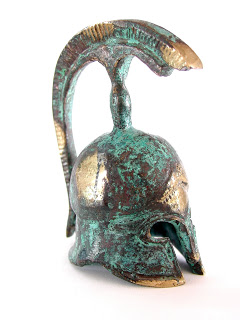 it to the gates of Troy, and then seem to retreat. Hidden inside the horse are Odysseus and his most trusted warriors. The Trojans, rejoicing at their defeat of the Greeks, drag the great offering into their city behind the high walls – and thus the fate of Troy was sealed. In less than three minutes, this teenager can see his predicament connecting him back, over thousands of years, to one of the greatest stories we have. That’s pretty rich meat. Traditional stories are sometimes referred to as “messages from our ancestors.” For myself, I would like to remain open to those messages, because there is wisdom there that may help me be a better person and a better parent.
it to the gates of Troy, and then seem to retreat. Hidden inside the horse are Odysseus and his most trusted warriors. The Trojans, rejoicing at their defeat of the Greeks, drag the great offering into their city behind the high walls – and thus the fate of Troy was sealed. In less than three minutes, this teenager can see his predicament connecting him back, over thousands of years, to one of the greatest stories we have. That’s pretty rich meat. Traditional stories are sometimes referred to as “messages from our ancestors.” For myself, I would like to remain open to those messages, because there is wisdom there that may help me be a better person and a better parent.
“Meaning in a story reflects our belief that there is meaning in the universe, that no matter the disorder that frames our lives, in the center – in the place that reveals who we are – there is order.” These words were spoken by beloved children’s book author, Katherine Paterson, National Ambassador for Young People’s Literature, Hans Christian Andersen Award Winner, Newbery winner, National Book Award winner – winner of too many accolades from around the world to list, so you can take her word for it! It’s never too late to learn that our stories are ours to shape. We are the authors of our own tales, and that connects us to all the other tales of the world. We are the heroes of own own stories. Let that give children courage. Let them grow strong on meat of the tongue.
